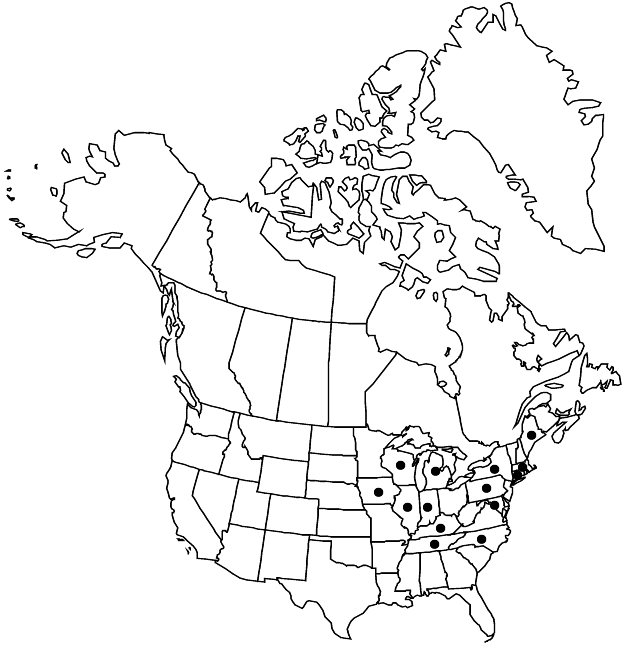Difference between revisions of "Lysimachia clethroides"
in A. P. de Candolle and A. L. P. P. de Candolle, Prodr. 8: 61. 1844 (as chlethroides) ,.
FNA>Volume Importer |
imported>Volume Importer |
||
| (3 intermediate revisions by 2 users not shown) | |||
| Line 1: | Line 1: | ||
{{Treatment/ID | {{Treatment/ID | ||
|accepted_name=Lysimachia clethroides | |accepted_name=Lysimachia clethroides | ||
| − | |accepted_authority=Duby | + | |accepted_authority=Duby |
|publications={{Treatment/Publication | |publications={{Treatment/Publication | ||
|title=in A. P. de Candolle and A. L. P. P. de Candolle, Prodr. | |title=in A. P. de Candolle and A. L. P. P. de Candolle, Prodr. | ||
| Line 7: | Line 7: | ||
}} | }} | ||
|common_names=Gooseneck loosestrife | |common_names=Gooseneck loosestrife | ||
| + | |special_status={{Treatment/ID/Special_status | ||
| + | |code=I | ||
| + | |label=Introduced | ||
| + | }} | ||
|basionyms= | |basionyms= | ||
|synonyms= | |synonyms= | ||
| Line 23: | Line 27: | ||
|elevation=0-300 m | |elevation=0-300 m | ||
|distribution=Conn.;D.C.;Ill.;Ind.;Iowa;Ky.;Maine;Mass.;Mich.;N.Y.;N.C.;Pa.;Tenn.;Wis.;e Asia;introduced also in nw Europe. | |distribution=Conn.;D.C.;Ill.;Ind.;Iowa;Ky.;Maine;Mass.;Mich.;N.Y.;N.C.;Pa.;Tenn.;Wis.;e Asia;introduced also in nw Europe. | ||
| + | |introduced=true | ||
|discussion=<p><i>Lysimachia clethroides</i> has been reported from Quebec, apparently as an adventive.</p><!-- | |discussion=<p><i>Lysimachia clethroides</i> has been reported from Quebec, apparently as an adventive.</p><!-- | ||
--><p><i>Lysimachia clethroides</i> is similar to another introduction from eastern Asia, the Manchurian loosestrife, L. barystachys Bunge. The latter is known in the flora area only from Clarke County, Georgia; it may be expected elsewhere; floral features are similar to those of <i>L. clethroides</i>; the two differ in vegetative features. <i>Lysimachia</i> barystachys has linear-elliptic to lanceolate or narrowly ovate leaf blades; <i>L. clethroides</i> has broadly elliptic to lanceolate or broadly ovate leaf blades. Reports of differences in floral length (J. D. Ray 1956) appear to be erroneous; J. Ohwi (1965) indicated that L. barystachys has corollas 7–12 cm in diameter versus 8–12 cm in <i>L. clethroides</i>; I have found dried garden flowers of <i>L. clethroides</i> measuring 7.5–10 cm.</p> | --><p><i>Lysimachia clethroides</i> is similar to another introduction from eastern Asia, the Manchurian loosestrife, L. barystachys Bunge. The latter is known in the flora area only from Clarke County, Georgia; it may be expected elsewhere; floral features are similar to those of <i>L. clethroides</i>; the two differ in vegetative features. <i>Lysimachia</i> barystachys has linear-elliptic to lanceolate or narrowly ovate leaf blades; <i>L. clethroides</i> has broadly elliptic to lanceolate or broadly ovate leaf blades. Reports of differences in floral length (J. D. Ray 1956) appear to be erroneous; J. Ohwi (1965) indicated that L. barystachys has corollas 7–12 cm in diameter versus 8–12 cm in <i>L. clethroides</i>; I have found dried garden flowers of <i>L. clethroides</i> measuring 7.5–10 cm.</p> | ||
| Line 33: | Line 38: | ||
-->{{#Taxon: | -->{{#Taxon: | ||
name=Lysimachia clethroides | name=Lysimachia clethroides | ||
| − | + | |authority=Duby | |
| − | |authority=Duby | ||
|rank=species | |rank=species | ||
|parent rank=genus | |parent rank=genus | ||
| Line 48: | Line 52: | ||
|publication title=in A. P. de Candolle and A. L. P. P. de Candolle, Prodr. | |publication title=in A. P. de Candolle and A. L. P. P. de Candolle, Prodr. | ||
|publication year= | |publication year= | ||
| − | |special status= | + | |special status=Introduced |
| − | |source xml=https:// | + | |source xml=https://bitbucket.org/aafc-mbb/fna-data-curation/src/2e0870ddd59836b60bcf96646a41e87ea5a5943a/coarse_grained_fna_xml/V8/V8_619.xml |
|genus=Lysimachia | |genus=Lysimachia | ||
|species=Lysimachia clethroides | |species=Lysimachia clethroides | ||
Latest revision as of 22:44, 5 November 2020
Stems erect, simple or sometimes branched apically, 3–10 dm, stipitate-glandular, especially distally, pubescent, or glabrous; rhizomes thickened; bulblets absent. Leaves alternate; petiole (0.1–)0.3–2 cm, eciliate; blade broadly elliptic to lanceolate or ovate, 5–11 × (1.6–)2–5 cm, base cuneate, decurrent, margins entire, plane (sometimes revolute), sparsely ciliolate or stipitate-glandular, apex acute to acuminate, surfaces punctate, pubescent or sparsely stipitate-glandular; venation pinnate. Inflorescences terminal, nodding racemes, 8–20 cm. Pedicels 0.4–1.5 cm, stipitate-glandular or pubescent. Flowers: sepals 5, calyx with longitudinal dark resin canals paralleling margins, 2.5–3.5 mm, pubescent or stipitate-glandular at least proximally, lobes lanceolate to ovate, margins thin; petals 5, corolla white, not streaked, campanulate to somewhat rotate, (4.5–)7–9 mm, lobes with margins entire, apex rounded, stipitate-glandular adaxially; filaments connate to 1.6 mm, shorter than corolla; staminodes absent. Capsules 1.5–3 mm, not punctate, glabrous.
Phenology: Flowering summer.
Habitat: Moist, shady meadows and other sites
Elevation: 0-300 m
Distribution

Introduced; Conn., D.C., Ill., Ind., Iowa, Ky., Maine, Mass., Mich., N.Y., N.C., Pa., Tenn., Wis., e Asia, introduced also in nw Europe.
Discussion
Lysimachia clethroides has been reported from Quebec, apparently as an adventive.
Lysimachia clethroides is similar to another introduction from eastern Asia, the Manchurian loosestrife, L. barystachys Bunge. The latter is known in the flora area only from Clarke County, Georgia; it may be expected elsewhere; floral features are similar to those of L. clethroides; the two differ in vegetative features. Lysimachia barystachys has linear-elliptic to lanceolate or narrowly ovate leaf blades; L. clethroides has broadly elliptic to lanceolate or broadly ovate leaf blades. Reports of differences in floral length (J. D. Ray 1956) appear to be erroneous; J. Ohwi (1965) indicated that L. barystachys has corollas 7–12 cm in diameter versus 8–12 cm in L. clethroides; I have found dried garden flowers of L. clethroides measuring 7.5–10 cm.
Selected References
None.